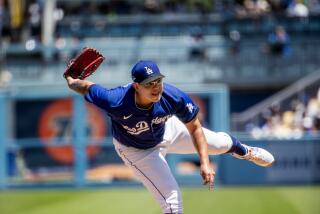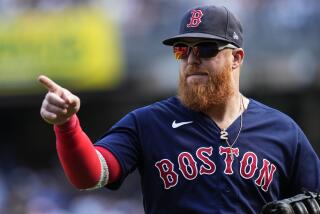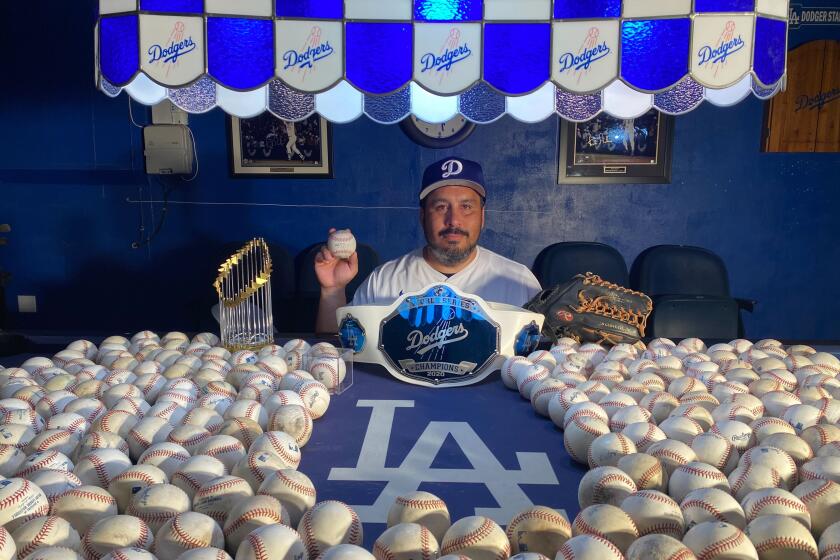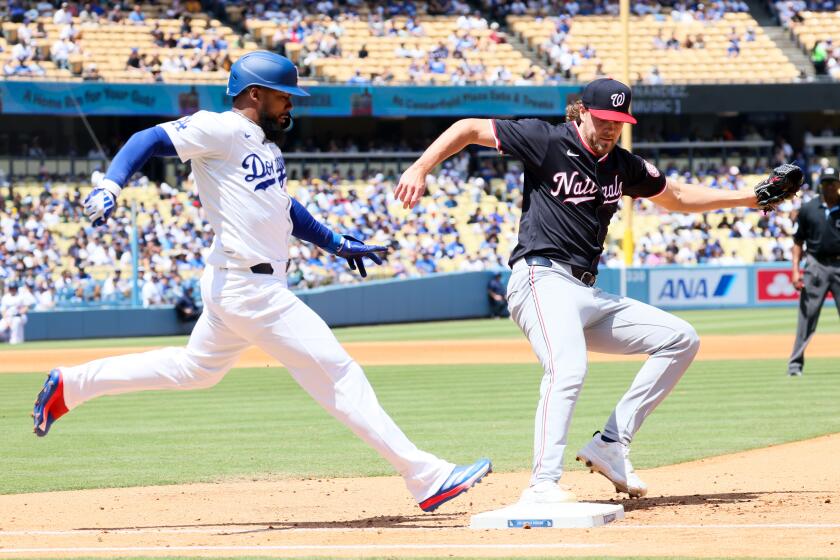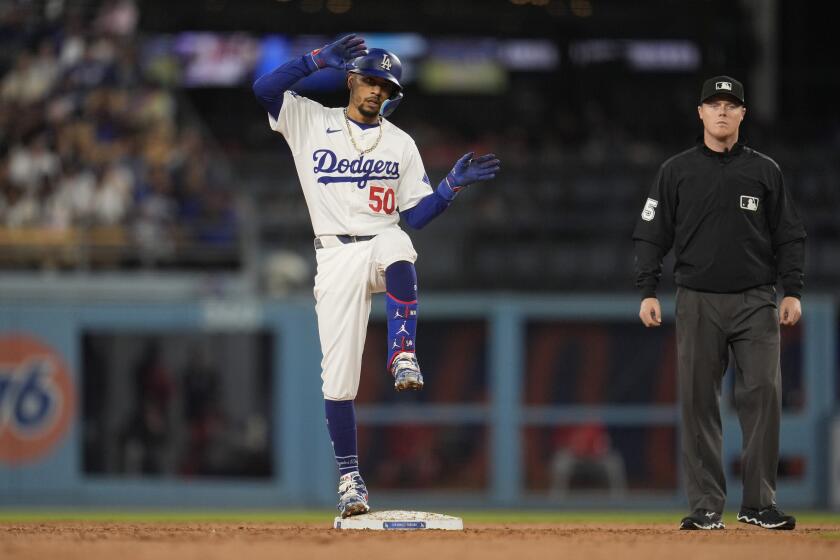Dodgers Dugout: Who’s going to replace Justin Turner?
Hi, and welcome to another edition of Dodgers Dugout. My name is Houston Mitchell, and it’s only eight days until the season starts.
Who replaces Justin Turner?
No one. Can’t replace a guy like Justin Turner and what he means to the lineup.
For those who missed it, the third baseman broke his left wrist when he was hit by a pitch during Monday’s Dodgers-Oakland spring training game. On Tuesday, the Dodgers announced that he would not need surgery, but there is no official word on when he will be back. The most hopeful prediction is the first or second week of May. The least hopeful is the end of June. You can read more about it here.
Broken wrists are unpredictable. Some players return and pick up like they were never injured. Some have lingering pain and see their production at the plate decrease. We won’t know for sure what Turner will be like until we see him play a couple of times.
So, the question remains, how do they replace Turner? General manager Farhan Zaidi said they don’t plan on trading for a third baseman, so that leaves some options.
1. Move Chris Taylor to third base and start Andrew Toles or Joc Pederson in center. This probably won’t happen because the Dodgers place a premium on defense. Taylor has only played 19 games at third base, Toles only 19 games in center. And Pederson is, well, Pederson. So you would be weakening two positions defensively with this move. Plus, Taylor put in a lot of work and has become a good center fielder. No reason to ask him to basically learn a new position again. It would probably give the Dodgers the best batting lineup though.
2. Put Kiké Hernandez at third. This is a possibility, but Hernandez has played only 23 games at third and has a career fielding percentage there of .914. That’s not good.
3. Move Logan Forsythe to third and platoon Chase Utley and Hernandez at second. This is what the Dodgers are leaning toward doing. Forsythe is about as good defensively as Turner and started 31 games there last season.
4. Move Forsythe to third, keep Kyle Farmer as the backup catcher and start Austin Barnes at second. This makes Yasmani Grandal the everyday catcher. Barnes isn’t brilliant on defense at second, but his bat should make up for that. I would bat Barnes, who had an OB% of .408 last season, second, drop Corey Seager to third and keep everyone else the same. Again though, I don’t think it will happen. And Barnes is struggling this spring, which makes this less feasible.
NL West rankings: the shortstops
Continuing the NL West rankings at each position:
A word on stats before we begin. OPS+ takes a player’s on-base plus slugging percentage and compares it with the league average. It also takes into account the player’s home field, so a hitter that plays in a pitcher’s park gets a slight boost, and vice versa. An OPS+ of 100 means he was an average hitter. 110 means he is 10% better than average, 90 means 10% worse.
WAR takes all of a player’s contributions on offense and defense and tells you how many wins that player is worth to the team as opposed to “what if that player was injured and the team had to replace him with a minor leaguer.”
As always, keep in mind that there is no one stat that gives you a full picture of a player and because I don’t want to bore you by just listing a ton of numbers, I pick five or six that give you a general idea of what kind of player each person was last season.
1. Corey Seager, Dodgers (.295/.375/.479/125 OPS+/5.6 WAR). There was no sophomore slump for Seager, who hopefully will retire around 2032 after a lengthy Hall of Fame career with the Dodgers filled with at least three World Series titles.
2. Brandon Crawford, San Francisco Giants (.253/.305/.403/87 OPS+/2.2 WAR). Crawford’s season was essentially ruined when his sister-in-law died at the age of 38 after an asthma attack. That happened on April 12. He took a couple of weeks off to grieve, help with the funeral and console his wife. After he returned, his wife suffered two miscarriages. If you ask Crawford, he won’t blame his off year on these things. But how could they not affect him? And how can anything I say in these rankings mean anything in the light of all of that? I’m putting him second because a 100% Brandon Crawford deserves to be there. And when the Giants play the Dodgers, instead of booing him, I’ll be hoping he succeeds. To read more on Crawford, click here.
3. Trevor Story, Colorado Rockies (.239/.308/.457/86 OPS+/2.6 WAR). Here’s an example of a sophomore slump. Story struck out a whopping 191 times last season, and his positive numbers declined in almost every category over his 2016 season. He is an average fielder and will be given plenty of chances to rebound because he is only 25.
4. Nick Ahmed, Arizona Diamondbacks (.251/.298/.419/78 OPS+/0.2 WAR). Ahmed is really good on defense, which is good because he is really bad on offense. See those bad offensive numbers listed for him just above? Those are his best numbers in four seasons in the majors.
5. Freddy Galvis, San Diego Padres (.255/.309/.382/83 OPS+/1.3 WAR). The Padres acquired Galvis to give them “stability” at the shortstop position. “Stability” apparently meaning “a guy who isn’t all that good.”
Ask Ross Porter
Former Dodgers announcer Ross Porter will be back this season to answer select reader questions. To send a question to Ross, email me and I will pass it on to him. Please include “Ask Ross Porter” in the subject line.
And finally
Ticket proceeds from seats where Kirk Gibson’s World Series home run ball landed will help Parkinson’s research. Read all about it here.
Have a comment or something you’d like to see in a future Dodgers newsletter? Email me and follow me on Twitter: @latimeshouston.
More to Read
Are you a true-blue fan?
Get our Dodgers Dugout newsletter for insights, news and much more.
You may occasionally receive promotional content from the Los Angeles Times.


